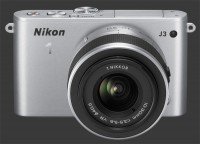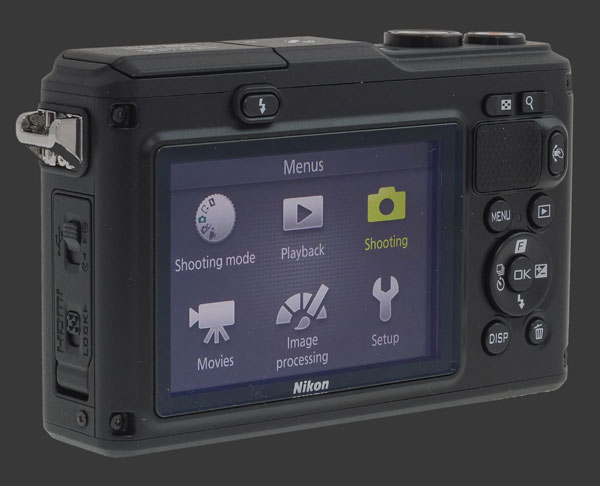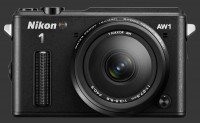Nikon 1 AW1 Review
Nikon 1 AW1 Performance - How well does it take pictures?
NOTE The Nikon 1 AW1 shares the same sensor as the recently reviewed 1 J3
Nikon 1 J3, results are not identical though due to a different processing pipeline. Still, the difference is virtually insignificant.
Performance starts with image quality, which is the criteria used as the foundation of our digital camera ratings. Ergonomic issues may get in the way, but in the end, image quality counts the most. For an ILC, image quality greatly depends on the lens used. While color, noise, exposure and dynamic-range are properties of a camera, distortion, vignetting and chromatic aberrations are properties of the lens. Sharpness and contrast depend on the weakest link. That is, a camera cannot capture more details than a lens lets through. Conversely, it is quite possible for a lens to transmit more details than a sensor can capture.

Image Noise & Details
The Nikon AW1 shows reasonable image-quality with relatively low image-noise up to ISO 800. Noise is barely noticeable at ISO 1600 and becomes obvious at ISO 3200. There is less color-noise than the on the J3, which shows that processing is different. This process also introduces more softness which makes ISO 3200 less usable this time.
Noise-reduction on the J3 is rather aggressive and increases in intensity quickly with longer shutter-speeds. As a result, usable print sizes vary with mid-size prints possible at ISO 1600 in good light but should be limited to ISO 800 in low-light. At ISO 3200 and 6400, noise becomes visibly more pronounced and even more fine details disappear. At this point, only small prints are acceptable.
Mirrorless cameras have been greatly improving lately and the AW1 is lagging when it comes to image-quality. The main weakness of this 2.7X crop sensor comes is reduced dynamic range. Nevertheless this is still vastly superior to all other underwater and rugged digital cameras to date.
Sharpness is not great at the default value of 2. Unfortunately, any setting above that clearly shows sharpening artifacts with halos appearing along edges.

Color & White Balance
This digital camera does generally well in terms of colors. Standard mode provides the most accurate. There is a warm tone by default which is easily corrected by adding +1 to Hue. The default Contrast level is a little strong and clips abruptly. Setting it to -1 produces images with more details without making them dull.
The AW1 has an average automatic white-balance system. AWB is tuned to produce slightly warm colors. It does occasionally fail to correct the strong color-cast of artificial light but not more than most. Custom while balance is good but not entirely perfect.
Exposure
The Nikon Matrix metering system used by the Nikon AW1 is exceptionally good. Exposure is quite consistent and accurate. Highlights are not blown out very often while results are generally bright enough to be usable as is. There is no Live-Histogram to preview exposure, nor is there an Exposure-Priority preview, but a luminance histogram is available during image playback.
Auto Focus
The Nikon 1 AW1 uses a hybrid autofocus system with both Phase-Detection and Contrast-Detection. Phase-Detection is done with 73 points right on the sensor, while Contrast-Detection is measured at 135 points. This digital camera decides which one to use depending on available light.
Phase-Detection has the advantage of being faster and not needing back and forth lens movements to confirm focus. The latter point is particularly important during video which gets recorded as the camera focuses. When light is too low, the camera switches to Contrast-detection.
Autofocus speeds, because of the hybrid system, are variable. When light is good to moderately low, this Nikon focuses quickly. For some reason, which may be attributed to the heavier waterproof lens, this camera does not focus as quick as other members of the Nikon 1 family.

Speed
The Nikon 1 AW1 is fast in some respects yet disappointing for others. General responsiveness is slower than average with some button pressed to take a while to register. Performance of this camera is characterized by the following numbers:
- Power-On: 1½ seconds. Average.
- Power-On to First-Shot: 2 seconds. Good.
- Autofocus: Highly variable, from under ¼s to a full second but usually quick even in moderate light. Good.
- Shutter-lag: Nearly instant with ¾s black-out. Average.
- Shot-to-shot: Roughly 1½s. Slow.
- Playback: ¼s to enter or exit. Good.
- Power-Off: Under ½s. Excellent.
- Video: ¾s start delay. Instant stopping. Slow to start, good to stop.
The performance of the AW1 depends on what it is being compared to. Among mirrorless cameras, its speed is below average but, again, it easily surpasses most underwater cameras in nearly all respects. It is of course a larger and more expensive model but no rugged camera compares to this one.
The Nikon 1 AW1 is powered by a proprietary Lithium-Ion battery which provides 220-shots per charge. With the GPS on, the battery gets drained even faster. This is noticeably below average and so a second battery is highly recommended.
Nikon 1 AW1 Performance - How well does it shoot video?

The Nikon 1 AW1 is a nice video performer. It can shoot full HD video at 1080p 30 FPS and 1080i 60 FPS with continuous Phase-Detect autofocus and stereo sound. There are also 720p 60 FPS and high-speed modes with frame-rates of 400 and 1200 FPS.
Full PASM exposure-modes are available for normal-speed video. Autofocus is available during video capture as is Manual Focus. Since Nikon 1 lenses lack a focus-ring, the magnify buttons must be used to select the focus-distance. No actual distance is shown, just a scale going from a flower to infinity. Focus moves in steps which requires pressing the button again and again. This easily shakes the camera, even on a tripod, so this is of limited use for video on the AW1.
Video is saved in Quicktime format using the efficient H.264 codec. This provides good compression and video quality without obvious artifacts. Motion appears very smooth with minimal distortion and the autofocus system keeps up reasonably well.
The only drawback is a ¾s delay when filming starts. Despite having a dedicated Video mode, which is the only way to correctly see what is being filmed, the sensor does not appear ready.
Nikon 1 AW1 Conclusion

As the only underwater and rugged camera with a relatively large sensor, nothing compares to the Nikon 1 AW1. This interchangeable lens camera is waterproof down to 15 meters, shockproof to 2m drops and freezeproof to -10C, making it the toughest camera around.
Its 1" high-speed CMOS sensor delivers slightly over-processed but good image-quality usable to ISO 1600 at least. Colors and white-balance are generally good while metering is excellent. Dynamic-range is superior to most fixed-lens cameras but behind the majority of mirrorless ones.
The sensor with hybrid Phase-Detect and Contrast-Detect autofocus lets the AW1 lock focus very quickly in good light. When light is low, autofocus slows down to average speeds. The shutter-lag is exceptionally fast while the black-out that follows is not. The all-electronic shutter of this camera delivers a class-leading continuous drive up to 60 FPS and shutter-speeds of up to 1/16000s.
The Nikon 1 AW1 is vastly different in use than most cameras. It has some exclusive capture modes which are genuinely useful, like Slow View, and others, like Motion Snapshot, that are gimmicky. Buttons are scarce and there is no mode-dial or control-dial which means using it outside of Auto mode is slow.
This unique camera delivers a new level of image-quality for underwater photography without spending a large sum of money on a waterproof enclosure. This is the raison d'etre of the Nikon 1 AW1. Those looking such an underwater camera should look no further. For overland use though, there are better and clearly more usable cameras.
 |
Please Support Neocamera
All information on Neocamera is provided free of charge yet running this website is a huge endeavor. Purchases made via affiliate links found throughout the site help keep it running and up-to-date. There is no additional cost to you, so please consider buying via these links to our affilates:
If you found any information on this site valuable and did not purchase via our affiliate links, please considering donating via PayPal:
Any amount will be greatly appreaciated. Thank you for your support!
Nikon AW1 Highlights

Sensor-Size: 13 x 9mm

Actual size when viewed at 100 DPI
| 14 Megapixels Mirrorless | ISO 160-6400 |
| Nikon 1 Mount 2.7X FLM | Shutter 1/16000-30s |
| Waterproof to 15m | Full manual controls, including Manual Focus |
| Weatherproof down to -10C | Custom white-balance with 2 axis fine-tuning |
| 60 FPS Drive, 60 Images | Spot-Metering |
| 1920x1080 @ 30 FPS Video Recording | Lithium-Ion Battery |
| 3" LCD 920K Pixels | Secure Digital Extended Capacity |
Updates
2025.01.18

Fujifilm GFX 2025 Lens Roundup
Lens Review roundup of Fujifilm GFX Medium-Format lenses. Quality, performance and handling of the GF20-35mm F/4R WR, GF30mm F/3.5 Tilt-Shift and the GF55mm F/1.7.
2024.11.18

Best 2024 Photography Gifts for Every Budget
Great gifts for photographers and photo enthusiasts selected for every budget among the best products of 2024.
2024.08.07

Eye Protection Tips for Professional Photographers
The four main considerations for professional photographers regarding eyewear.
2024.07.14

Fujifilm X100VI Review
Flagship fixed-lens compact digital camera with a 40 MP sensor and Image-Stabilization, a first for the series. Retro design featuring dual control-dials, plus direct ISO, Shutter-Speed and EC dials. Its hybrid viewfinder can switch between EVF and OVF mode.
2024.05.09

Fujifilm GFX100 II Review
Flagship 102 Megapixels Medium-Format Mirrorless Digital Camera with 8-Stop 5-Axis IBIS, 8 FPS Drive, 8K Video and 400 MP Super-Resolution capture in a weatherproof and freezeproof body with dual control-dials and dual memory-card slots.
2024.04.03

Fujifilm X-T5 Review
Newest Fujifilm flagship boasting a 40 MP APS-C sensor, 5-axis IBIS with 7-stop efficiency, 15 FPS continuous drive, 6.2K Video capture, dual control-dials and dual SDXC UHS-II slots in a sturdy weatherproof and freezeproof body.
2023.11.20

Best Digital Cameras of 2023
Find out which are the Best Digital Cameras of 2023. All the new Mirrorless Digital Cameras from entry-level to high-end professional.
2023.07.10

Fujifilm X-H2 Review
40 Megapixels APS-C Hybrid Mirrorless Digital Camera with 7-stop IBIS. Fastest shutter ever and 8K video capture. Large builtin EVF with 0.8X magnification and 5.8 MP, plus an Eye-Start Sensor. Packed with features and large number of controls in a weatherproof and freezeproof body.
2023.05.07

Sony FE 20-70mm F/4G Review
Review of the unique Sony FE 20-70mm F/4G lens. The optical zoom of this lens spans ultra-wide-angle and medium focal-length coverage, making it one of the most versatile Full-Frame lenses on the market.
2023.01.15

Huion Inspiroy Dial 2 Review
Review of the Huion Inspiroy Dial 2 tablet, a medium sized drawing surface with dual dials and customizable buttons. Connects via USB-C or Bluetooth 5.0 with Windows, Linux and Android support.
2022.12.08

How to Pack for a Photo Trip
Find out how to pack for a travel photography trip, carry your gear safely while meeting airline regulations.
2022.11.13

Best Digital Cameras of 2022
The best digital cameras of 2022. A short list of the most outstanding models in their respective categories. Choose one for yourself or as a gift.












